





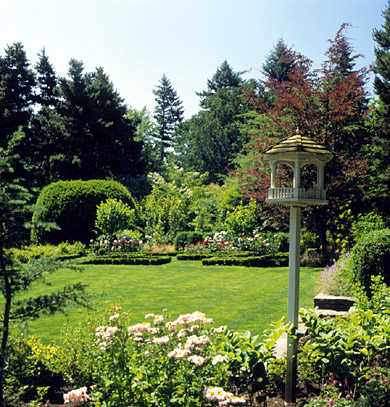 A beautiful lawn completes a yard.
A beautiful lawn completes a yard.
Whether you're starting a new lawn or reviving an existing one, it helps to approach the growing of grass the way you would any other plant. A lawn is made up of thousands or millions of individual grass plants -- as many as 850 plants per square foot. All grasses may look more or less the same, but different types have different levels of insect and disease resistance; drought, shade, and foot-traffic tolerance; and temperature hardiness.
A lawn usually contains a combination of many grass types. Picking the right mixture for the conditions in your yard is essential. Just as a plant that thrives in dry soil will likely die in a boggy spot, an out-of-place grass will grow poorly or not at all. For example, cool-season grasses prefer a temperature range of 60-75 degrees and generally require less water, but summer heat can stress them. Warm-season grasses thrive in higher temperatures (80-95 degrees), but they lose their color when the mercury drops. However, warm-season grasses typically have deeper roots and can tolerate close mowing and heavy foot traffic.
continue reading belowAfter you've picked the right grass, you have to decide how to plant it. As with other annuals and perennials, you can start grass from seed or put live plants in the ground. With grass, that means sod. Sod is the quickest, easiest way to start a new lawn -- but usually the most expensive. Sod yields a usable lawn in a few weeks. You might be able to lay a section of sod yourself, but large jobs probably demand professional installation. Grass seed is generally much cheaper than sod and can be sown by a do-it-yourselfer. However, it requires extensive preparation, timing, and careful follow-up care. You'll need patience, too, because seeded lawns can take months to establish. Plus, some grasses just don't start well from seed, leaving sod or plugs -- small chunks of sod "plugged" into the ground -- as your only options.
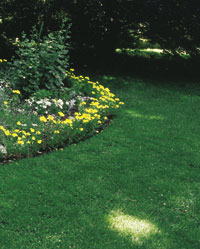
Whether you sod or seed, your soil must be grass-friendly: deep, friable (crumbly), fertile, and well-draining. If the ground is seriously lacking in these requirements, fix the problems before you put in your new lawn. Build up shallow soil with a few inches of weed-free topsoil. Improve friability and fertility by working in compost, manure, or other organic matter. Solve drainage problems by changing the grade of your yard or installing a subsurface drainage system.
Less expensive drainage solutions include simple swales, baffles, and contours. Swales are long, narrow, shallow depressions that divert runoff. Baffles are small pieces of edging buried partly in the ground to slow runoff and let water soak in. Contours are ripples or bumps in the ground that intercept water and divert it through perforated pipes laid just under the surface.
Lawns love water like children love toys, but you can spoil both by giving them what they want too often. New lawns require more water than established ones, but too much is hazardous to any lawn's health. Overwatering keeps the top layer of soil wet, encouraging grass to develop weak, shallow roots, the kind that leads to quick injury in hot, dry weather. Infrequent but deep watering provides the best results.
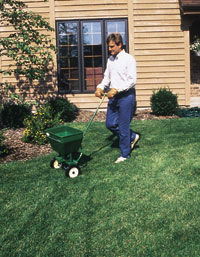
Lawns need to be fed as well as watered, but the diet must be strict. Overfertilizing can be as harmful as overwatering. Too much fertilizer leaves plants weak and top-heavy, making them perfect targets for disease and insects. Fertilize only if a soil test reveals a deficiency. Otherwise, if you must give your lawn a snack, it makes sense to fertilize only during growth spurts in the spring and fall.
The type of fertilizer you choose and when you apply it depend on the type of grass. Most commercial fertilizers are a combination of nitrogen, phosphorus, and potassium. Of these ingredients, the most important for grass is nitrogen, which promotes leaf growth and good color. You already have an excellent source of nitrogen grass clippings. Leaving clippings on the lawn is a cheap, easy way to fertilize.
Despite your best efforts to keep your lawn well fed and healthy, it still may fall victim to weeds. Any weed can be removed by hand, but if you don't get the whole plant, you'll find yourself bending and pulling again and again. Weeds over a large area may demand a chemical solution.
If you had a weed problem last year, apply an herbicide in early spring. A pre-emergent control can wipe out crabgrass by killing the young plants as they sprout. Another application in late spring can help control dandelions and other broad-leaved (nongrass) weeds. To save time, weed and feed simultaneously by applying a combination herbicide and fertilizer. If you're cautious about chemicals, soap herbicides are less toxic than others. Don't broadly apply any herbicide in summer, when your lawn is most stressed by heat.
If all this feeding and weeding sounds a little daunting, there's no shame in checking into a lawn service. Call around and price their services, then compare what you would pay for lawn products applied yourself. You may find that the costs are similar.
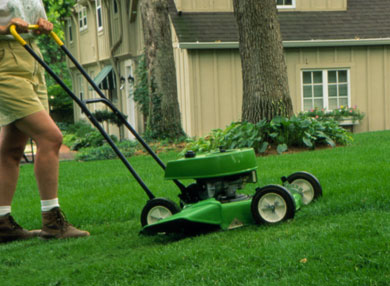 Go ahead: mow your grass morethan once a week.
Go ahead: mow your grass morethan once a week.
If your grass is growing, you'll be mowing. You probably like to keep your hair at a certain length with regular trims, and that's what grass likes, too. Each grass type looks best and stays healthiest at a certain height. Use your mower to maintain that height as closely as possible. Giving your lawn a too-short crew cut can be just as damaging as letting the grass grow to hippie length. The basic rule of mowing is never to cut more than one-third of the leaf blade. If this works out to mowing every Saturday, great. However, weather and growth spurts may require adjusting your schedule. Despite what your dad might have said, it's OK to mow your lawn a second time during the week.
It's also important not to scalp your lawn, a common sin. In the cooler weather of spring and fall, grasses should be cut at 2 to 2-1/2 inches. When temperatures start topping 80 degrees, let the grass get taller -- as tall as 3-1/2 inches for bluegrass. It won't have the same perfect appearance as a lawn cut shorter, but it will more than make up for style in plant health. Taller blades shade the ground, conserving moisture and preventing weed seeds from germinating.
The right grass, good soil, and timely care should have you well on the way to a champion lawn. Be patient -- a lawn, like the other living parts of your landscape, takes several seasons to mature and fill in completely. When it does, don't be surprised to catch a few neighbors admiring your lawn and wondering what your secret is.
Unless your yard is somehow blessed with perfectly timed rainfall throughout the growing season, you'll need to supplement nature's water supply with your own. Here are some tips for watering grass wisely:
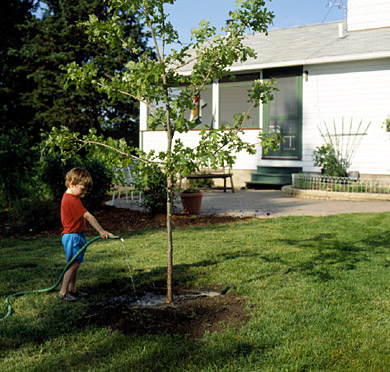
Copyright © www.100flowers.win Botanic Garden All Rights Reserved